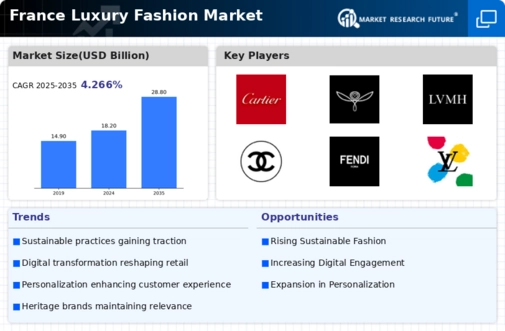E-commerce Expansion
The luxury fashion market in France is witnessing a significant shift towards e-commerce, which is reshaping consumer shopping behaviors. In 2025, online sales in the luxury segment are projected to account for approximately 30% of total sales, reflecting a growing preference for digital shopping experiences. This trend is driven by the convenience and accessibility that e-commerce platforms offer, allowing consumers to explore a wider range of luxury products from the comfort of their homes. Additionally, the luxury fashion market is adapting to this shift by enhancing online customer experiences through virtual try-ons and personalized recommendations. As brands invest in their digital presence, the potential for increased sales and customer engagement appears promising, suggesting that e-commerce will continue to be a crucial driver for the luxury fashion market.
Rising Affluence of Consumers
The luxury fashion market in France is experiencing a notable surge in consumer affluence, which is driving demand for high-end products. As disposable incomes rise, particularly among millennials and Gen Z, there is an increasing willingness to invest in luxury items. In 2025, the average disposable income in France is projected to reach approximately €30,000, which may lead to a 15% increase in luxury fashion purchases. This trend indicates that consumers are prioritizing quality and exclusivity, thereby enhancing the overall growth of the luxury fashion market. Furthermore, the affluent demographic is increasingly seeking unique and artisanal products, which could further stimulate market expansion. The luxury fashion market is thus poised to benefit from this demographic shift, as brands adapt their offerings to cater to the evolving preferences of wealthier consumers.
Cultural Influence and Heritage
France's rich cultural heritage plays a pivotal role in shaping the luxury fashion market. The country's historical significance in fashion, particularly in cities like Paris, continues to attract both domestic and international consumers. In 2025, it is estimated that cultural tourism will contribute approximately €20 billion to the French economy, with a substantial portion directed towards luxury fashion. This cultural allure not only enhances brand prestige but also fosters a sense of authenticity that consumers increasingly value. The luxury fashion market thrives on this cultural narrative, as brands leverage their heritage to create compelling stories that resonate with consumers. As a result, the interplay between culture and luxury fashion is likely to remain a driving force, influencing purchasing decisions and brand loyalty.
Technological Innovations in Retail
Technological advancements are significantly impacting the luxury fashion market in France, particularly in retail operations. Innovations such as augmented reality (AR) and artificial intelligence (AI) are enhancing the shopping experience, allowing consumers to interact with products in novel ways. In 2025, it is projected that 25% of luxury brands will implement AR features in their online platforms, providing immersive experiences that could drive consumer engagement. The luxury fashion market is thus leveraging technology to create personalized shopping experiences, which may lead to increased customer satisfaction and loyalty. Furthermore, the integration of AI in inventory management and customer service is likely to streamline operations, potentially resulting in cost savings and improved efficiency. As technology continues to evolve, its influence on the luxury fashion market is expected to grow, shaping the future of retail.
Sustainability and Ethical Practices
The luxury fashion market in France is increasingly influenced by sustainability and ethical practices, as consumers become more conscious of their purchasing decisions. In 2025, it is estimated that 70% of luxury consumers will prioritize brands that demonstrate a commitment to sustainable practices. This shift is prompting luxury brands to adopt eco-friendly materials and transparent supply chains, which could enhance their appeal to environmentally aware consumers. The luxury fashion market is thus responding to this demand by integrating sustainability into their core strategies, potentially leading to a 20% increase in sales for brands that successfully communicate their ethical initiatives. As sustainability becomes a key differentiator, the luxury fashion market is likely to evolve, with brands that embrace these values gaining a competitive edge.
























Leave a Comment